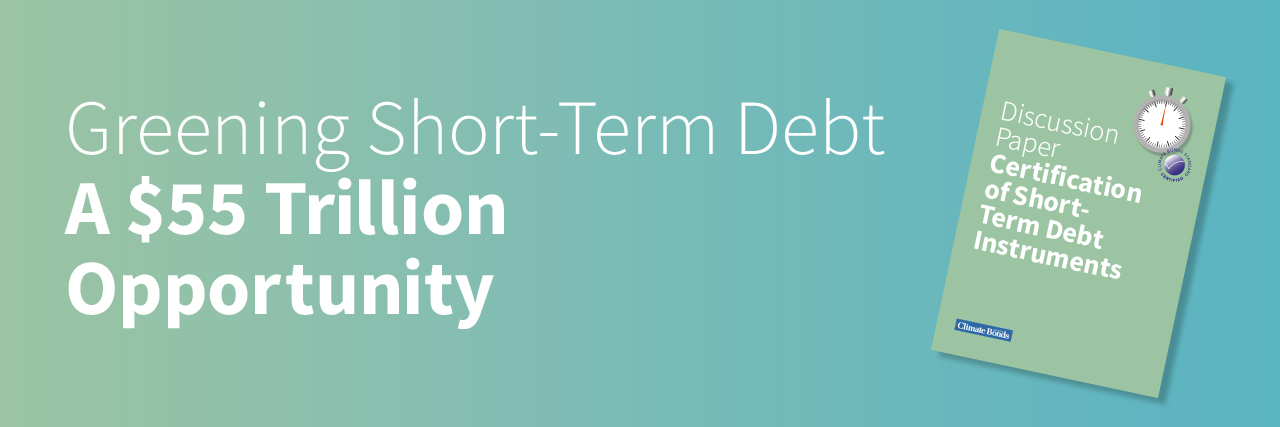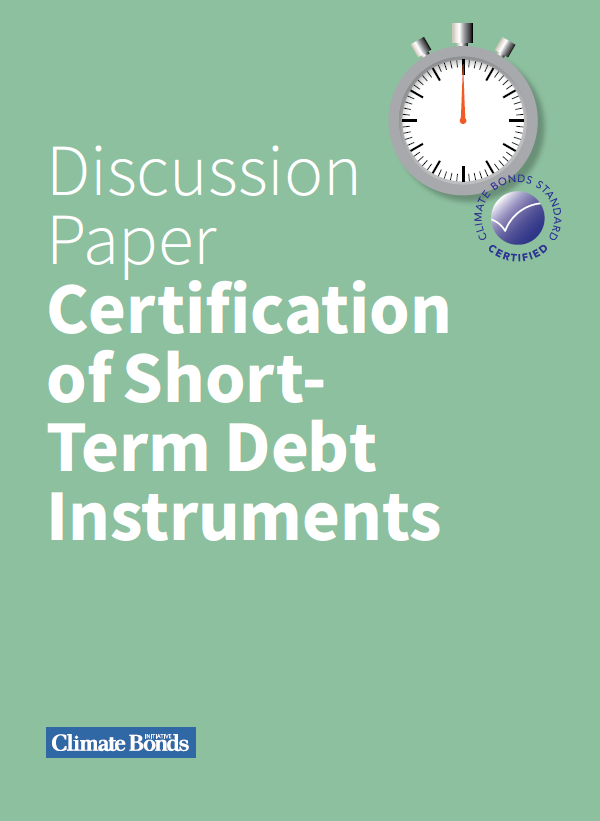
Climate Bonds' discussion paper outlines how green finance can expand into huge market

The estimated $55 trillion value of global short-term debt markets offers an enormous pool of capital, on top of the global bond market, in which green finance can expand. Broadening the reach of climate considerations into new corners of global capital can help the scaling of this market and can boost investment towards the Climate Bonds’ objective of $5trillion in annual green finance by 2025.
Green short-term markets will reward issuers that have institutionalised strong environmental practices, by giving them greater access to investment. It will also catalyse financing for issuers who would benefit from green debt products that offer flexibility in the more immediate future, ultimately adding a further dimension to green financing.
The rapid growth of investor appetite for green bonds, including some initial short-term paper, suggests there is potential to develop this market as a deep and liquid source of green capital.
Short-term debt: How will this work?
Short-term instruments can be a useful tool in meeting the Issuer's environmental objectives both under the Use of Proceeds (UoP) principle and for green pureplay or transitioning entities.
For green Certified short-term debt based on UoP, the proceeds should be allocated to green projects or assets aligned with Climate Bonds Criteria. Short-term debt proceeds could be used for pre-financing or for covering operating expenditures, such as depollution work, R&D, contracts with green electricity suppliers etc.
A pureplay entity – an entity with mostly green activities -would be crucial to the growth of this market, because short-term debt instruments are frequently used for general corporate funding. Qualifying entities could then label all their debt as green, regardless of tenor.
Climate Bonds are working on defining ‘pure-play’ entities under the Climate Bond Standard, to facilitate the Certification of ‘pure-play’ activities.
Short-term debt: Who can benefit?
Investor appetite for green debt has proven to be strong in the bond market, with demand outstripping supply, causing oversubscriptions and the phenomena of the greenium – a pricing benefit felt by issuers due to this disparity in supply and demand dynamics. Expanding green finance into short-term markets can offer a further supply stream.
Investors generally benefit from the increased flexibility in managing the maturity profiles of their portfolios that short-term assets offer. Investors may use such instruments to these ends whilst also greening and diversifying their investment portfolio.
Corporates which issue short-term debt as part of their general funding policy will be able to benefit from the demand for green finance whilst also meeting their environmental objectives. By self-labelling short-term instruments as green, an issuer may attract greater investor interest. Certification under the Climate Bonds Standard offers a further step issuers can take to show investors they are engaging with best practice green financing.
Climate Bonds Standards and Certification can drive short-term market
As an established pioneer of green market practices, Climate Bonds is well placed to shape a new green market with integrity, analysis and standards and guidance. Several short-term debt instruments are already applicable for Certification under the Climate Bonds Standard.
- Commercial Paper (CP)
- Revolving Credit Facilities (RCF)
- Short-term bank loans
- Export Letters of Credit
- Certificate of Agribusiness Receivables (CAR)
- Floating Rate Notes
- Green Repurchase Agreements (Repos)
- Export Financing in Brazil
…and the Paper lists several more including examples of short-term green issuances that have been certified under the Climate Bonds Standard (pages 5-7).
In May of this year, Austria announced it would become the first government to include short-term debt instruments like treasury bills and commercial paper in its green debt programme.
FAQ’s –
1. How can short-term instruments become certified under the Climate Bonds Standard? See SECTION 5 of the paper
2. What types of short-term instruments can be certified? See SECTION 5 of the paper
3. Are short-term instruments suitable for financing long term green investments and under what conditions? See section SECTION 5 of the paper
4. What examples are there of Certified green short-term instruments? See SECTION 6 of the paper
5. Often Issuers use short-term instruments for general operating expenses rather than UoP. Can such instruments be certified? See SECTION 5 of the paper
6. Should there be concerns about Double Counting in the certification of short-term instruments? See SECTION 5 of the paper
The Last Word
Saving our planet from irreversible climate catastrophe will require an entire redevelopment of how we run our economies and finance has a pivotal role to play. Rigorous and credible green labelling of short-term debt instruments against market standards and accepted taxonomies marks a natural progression of the sector.
Sean Kidney, CEO, Climate Bonds: “The race to save our planet from climate catastrophe will necessitate $5trillion annual green investment by 2025. Taking new thinking to finance is the Climate Bonds way and we believe that inroads into the short-term markets is the necessary next chapter in the green finance revolution.”
Climate Bonds will deliver more updates on this Short-term debt project over the coming weeks and months, including a series of webinars and roundtables involving industry leaders.
To stay tuned for these updates, register your interest here: http://ow.ly/bbpT50K0k3P
‘Til next time
Climate Bonds
